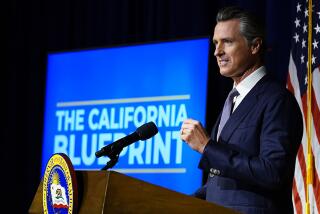Debate on Tax Structure Still to Come
- Share via
SACRAMENTO — In the budget that Gov. Gray Davis proposed Friday, he recommended billions of dollars in tax increases and even more in cuts to programs. But he left for another day the debate over how fundamentally to alter California’s tax system to bring long-term stability to the state.
As a result, the budget that Davis proposed does not close debate on that issue -- known as structural tax reform -- but rather opens it, setting the stage for a legislative session dominated by what the governor refers to as the boom and bust of the state’s budget.
Asked Friday whether Davis’ spending plan would make California’s tax system more stable, Timothy Gage, the administration’s outgoing finance director, responded bluntly: “It doesn’t.”
Although Davis has said that he would not sign a budget that does not include structural reform, some observers said they understood his reluctance to include it in his opening proposal.
“He could have put out his idea of the perfect proposal and you still would have had to put in tens of thousands of hours,” said Jean Ross of the California Budget Project, a private group that tracks the budget process. “He understands that there are many interest groups that will be involved. In order to make it work, you need stakeholders and you need legislators involved. It is extraordinarily complex.”
In the meantime, Davis presented an opening gambit that spreads pain and political advantage. For liberals, he endorsed tax increases for the rich; for conservatives, he included $11.8 billion in spending cuts. And for the rest, he advocated a 1-cent increase in the state sales tax, a move that would bring some stability to government finances at the cost of minimal political opposition.
Legislators are convinced that the tax increases that Davis proposes are ones that are least offensive to voters. The one broad tax increase -- the 1% boost in the sales tax -- would add $1 to the cost of a $100 purchase.
Still, that tax increase and the others contained in his proposal face significant political opposition, making a return to the issue of structural reform inevitable, not only for long-range stability but also to balance this $96.4-billion budget.
“Those taxes are not real,” said John Hein, head of governmental affairs for the California Teachers Assn. The governor’s objective, Hein said, was to get the budget “off the desk. We won’t see much of this ever again.”
Some of the proposed increases also rest on assumptions that may not materialize. The governor, for instance, is counting on $1.5 billion from the state’s Indian casinos, but that depends on the willingness of the casinos to renegotiate their agreements with the state government in return for expanded gambling opportunities. If they refuse, that money may not be forthcoming.
For weeks, Davis has touted the importance of stabilizing the state government’s cash flow.
On Friday, he reiterated that message with a list of areas that he says are vital for achieving that goal.
Without offering specifics, Davis encouraged legislators to give governors more power, to regularly reconsider tax breaks and to give local government power over taxation. But for the most part, the ideas are vague.
“The state needs to examine ways to more fairly allocate the tax burden and reduce revenue volatility,” the governor said, for instance.
What Davis did not do is introduce a proposal for substantially changing the sources of the state’s revenue.
California’s tax structure is volatile partly because it relies on wealthy people to pay the bulk of the state’s income taxes.
Wealthy people’s income fluctuates the most, and they are the ones most affected when stock markets rise or fall.
One solution could be to impose higher income taxes on middle-income Californians, essentially flattening the state’s progressive tax code. But that would have its greatest effect on the state’s middle class, and would lose Democratic support.
As the budget moves to the Legislature, Davis’ general notions will become the object of more specific debate.
Any serious discussion of overhauling the tax structure will probably involve a review of the property tax system, which has been sacrosanct in the 25 years since voters approved Proposition 13, slashing property taxes. Any change in Proposition 13 would require approval by the electorate in a statewide ballot measure.
“It is a very complicated political thicket,” said Sen. Don Perata (D-Alameda).
“He would prefer to see it arise out of a political discussion in the Legislature. It is going require a great deal of consensus-building.”
Democratic legislators working on the tax issue are considering expanding the sales tax to include services, such as movies and sporting events, and to Internet sales.
By expanding the sales tax to include services, the state could lower the overall sales tax rate, which would be as much as 9.5% in some counties if Davis’ proposal is approved.
Although politically charged, those proposals would go further toward stabilizing the state’s revenue and meeting Davis’ goal of structural reform.
In fact, Davis administration officials acknowledged Friday that their own proposal needs improvement in that area.
Without fundamental reforms, Gage said, the government is “stuck with the tools and the box that we’ve got.”
More to Read
Get the L.A. Times Politics newsletter
Deeply reported insights into legislation, politics and policy from Sacramento, Washington and beyond. In your inbox twice per week.
You may occasionally receive promotional content from the Los Angeles Times.









